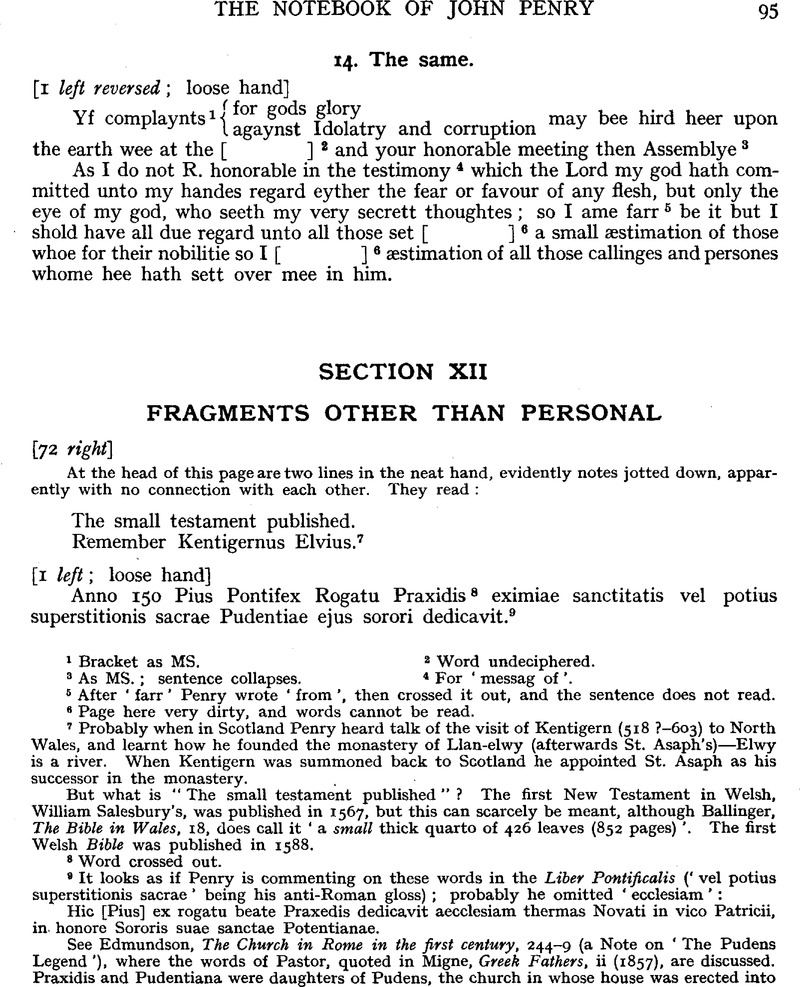No CrossRef data available.
Article contents
Section XII: Fragments other than Personal
Published online by Cambridge University Press: 24 December 2009
Abstract

- Type
- The Notebook of John Penry, 1593
- Information
- Copyright
- Copyright © Royal Historical Society 1944
References
page 95 note 7 Probably when in Scotland Penry heard talk of the visit of Kentigern (518 ?–603) to North Wales, and learnt how he founded the monastery of Llan-elwy (afterwards St. Asaph's)—Elwy is a river. When Kentigern was summoned back to Scotland he appointed St. Asaph as his successor in the monastery.
But what is “The small testament published” ? The first New Testament in Welsh, William Salesbury's, was published in 1567, but this can scarcely be meant, although Ballinger, The Bible in Wales, 18, does call it ‘a small thick quarto of 426 leaves (852 pages)’. The first Welsh Bible was published in 1588.
page 95 note 8 Word crossed out.
page 95 note 9 It looks as if Penry is commenting on these words in the Liber Pontificalis (‘vel potius superstitionis sacrae’ being his anti-Roman gloss) ; probably he omitted ‘ecclesiam’ : Hic [Pius] ex rogatu beate Praxedis dedicavit aecclesiam thermas Novati in vico Patricii, in honore Sororis suae sanctae Potentianae.
See Edmundson, The Church in Rome in the first century, 244–9 (a Note on ‘The Pudens Legend’), where the words of Pastor, quoted in Migne, Greek Fathers, ii (1857), are discussed. Praxidis and Pudentiana were daughters of Pudens, the church in whose house was erected into a parish titulus Pastoris, Pastor being the reputed brother of Pius. After the death of Pudens, his daughters obtained the consent of Pius to the building of a baptistery adjoining the church ; the Bishop himself drew the plans and frequently visited the church. The entry in Migne, 1024, reads as follows [Edmundson shows that the interpolation in brackets is based on a mistake] : 8. Eodem tempore virgo Domini Praxedis accepta potestate rogavit beatum Pium episcopum, ut thermas Novati, quae jam tune in usu non erant, ecclesiam consecraret: quia aedificium magnum in iisdem et spatiosum esse videbatur. Quod et placuit sancto Pio episcopo, thermasque Novati dedicavit ecclesiam, sub nomine beatae virginis Potentianae (in vico Patricius. Dedicavit autem et aliam sub nomine sanctae virginis Praxedis) infra urbem Romam, in vico qui appellatur hater anus, ubi constituit et titulum Romanum ; in quo loco consecravit baptisterium sub die IV Idus Maii. Post duos annos facta persecutio magna Christianorum : et multi martyrio coronati sunt. Quo tempore virgo Domini Praxedis multos Christianos occultabat in praefato titulo, quos et cibo pascebat et Dei verbo. Tune divulgatum est Antonio imperatori, quod conventus fierent Christianorum in titulo Praxedis.




